The Rev. James W. Goolsby, Jr., senior pastor of the First Baptist Church, left, and the Rev. Scott Dickison, senior pastor of First Baptist Church of Christ, right, pose for a photo at Dickison's church in Macon, Ga., on Monday, July 11, 2016. There are two First Baptist Churches in Macon _ one black and one white. Two years ago, Dickison and Goolsby met to try to find a way the congregations, neighbors for so long, could become friends. Theyâd try to bridge the stubborn divide of race. (AP Photo/Branden Camp)
The Associated Press
MACON, Ga. (AP) - There are two First Baptist Churches in Macon - one black and one white. They sit almost back-to-back, separated by a small park, in a hilltop historic district overlooking downtown.
About 170 years ago, they were one congregation, albeit a church of masters and slaves. Then the fight over abolition and slavery started tearing badly at religious groups and moving the country toward Civil War. The Macon church, like many others at the time, decided it was time to separate by race.
___
EDITOR'S NOTE - This is part of Divided America, AP's ongoing exploration of the economic, social and political divisions - and in some cases attempts at reconciliation - in American society.
___
Ever since - through Jim Crow, the civil rights movement, desegregation and beyond - the division endured, becoming so deeply rooted it hardly drew notice.
Then, two years ago, the Rev. Scott Dickison, pastor of the white church, and the Rev. James Goolsby, pastor of the black church, met over lunch and an idea took shape: They'd try to find a way the congregations, neighbors for so long, could become friends. They'd try to bridge the stubborn divide of race.
They are taking up this work against a tumultuous backdrop, including the much-publicized deaths of blacks at the hands of law enforcement and the rise of the Black Lives Matter movement.
Next month, they will lead joint discussions with church members on racism in the history of the U.S., and also in the history of their congregations.
"This is not a conversation of blame, but of acceptance and moving forward," Goolsby said.
___
Like many American institutions, houses of worship have largely been separated by race, to the point that the Rev. Martin Luther King Jr. called Sunday mornings "one of the most segregated hours." Recently, several denominations, from the Episcopal Church to the Southern Baptist Convention, have tried to look critically at their past actions going back centuries.
In the early 1800s, in Baptist churches of the South, whites and blacks often worshipped together, but blacks were restricted to galleries or the back of the sanctuary. Eventually, black populations started growing faster in many communities. Whites, made uneasy by the imbalance, responded by splitting up the congregations.
This was apparently the case for First Baptist in Macon, which built a separate church for blacks in 1845, then finalized the separation two decades later soon after the Civil War ended.
Goolsby and Dickison said their respective churches were enthusiastic about plans to work together, under the auspices of the New Baptist Covenant, an organization formed by former President Jimmy Carter to unite Baptists.
Yet excitement mixed with apprehension, since the effort would inevitably require "some challenging conversations," Dickison said, including a re-examination of the official church history, which had been recorded in mostly benign terms, with almost no recognition of racism.
"We need to go through this kind of conversion experience of confession, of repentance and of reconciliation. We need to have that when it comes to race, not just in the country but within the church," Dickison said.
___
Goolsby recalled that after the massacre last year at the historic black church in Charleston, South Carolina, he was outside a store, awaiting his wife, when Dickison called.
"Scott shared how he felt, how he was struggling with what he would share with his congregation," Goolsby said. Dickson asked how he could show support.
"I said, 'We're already doing it,'" Goolsby said. "The mere fact he thought to call me was huge."
The stakes were even more personal months later, when the white church invited black church members for a youth trip to Orlando.
Goolsby's teenage son was among those invited. But Goolsby had considered Florida a danger ever since Trayvon Martin, an unarmed, black 17-year-old, was fatally shot in Sanford by George Zimmerman, a neighborhood watch volunteer who was later acquitted of second-degree murder and manslaughter charges.
The pastor could not let his son go on the trip. "If you put a hoodie on him," he said, "he looks just like Trayvon."
The concerns of anxious black parents had been much in the news, but the white church members hadn't had to confront the issue directly until Goolsby raised it.
After reassurances from a white chaperone, Goolsby allowed his son and the other young people to participate.
"The fact that that was so easy to share - we've already made progress," Goolsby said.
____
Dickison strode into the basement hall of his church with a box under one arm. Inside, were copies of "Strength to Love," a collection of sermons and writings by King. The book was at the center of classes at the white church that Dickison organized in preparation for the joint talks on racism next month.
This class was held on the Sunday in July after the fatal police shootings of Alton Sterling in Louisiana and Philando Castile in Minnesota, and the fatal ambush on white Dallas police officers.
With the stifling humidity of a Georgia summer building outside, Dickison launched into a discussion of King's sermon on the Good Samaritan, about despised groups and showing mercy.
"We have our tribes. We see ourselves over and against others," he said, then asked church members to reflect.
One man said when you reach out to someone from another group, "you're perceived as unpatriotic," or disloyal. A woman said she was upset to see some disrespect of the police. "They rush toward danger when others run," she said.
The next night, the black church hosted the city's Black Lives Matter vigil, marking the tragedies of the preceding week.
Clergy from across the city filled the pulpit. Goolsby and Dickison stood together to speak. Dickison compared racism to "a cancer that roams inside the body of this nation, and yes, even in the body of Christ." Goolsby urged people to maintain hope "in spite of our circumstances," and he added, "We know there will be change."
Then both men said, "Amen."
This Sunday, July 10, 2016 photo shows the First Baptist Church, left, the First Baptist Church of Christ, center, and Saint Joseph's Catholic Church in Macon, Ga. About 170 years ago, the two Baptist churches were one congregation, albeit a church of masters and slaves. Then the fight over abolition and slavery started tearing badly at religious groups and moving the country toward Civil War. The Macon church, like many others at the time, decided it was time to separate by race. (AP Photo/Branden Camp)
The Associated Press
A parishioner at First Baptist Church, a predominantly African-American congregation, leaves after a worship service in Macon, Ga., on Sunday, July 10, 2016. There are two First Baptist Churches in Macon _ one black and one white. (AP Photo/Branden Camp)
The Associated Press
This Monday, July 11, 2016 photo shows the First Baptist Church, a predominantly African-American congregation, in Macon, Ga. In the 1840s, whites maintained oversight of the church as required by Georgia law at the time for fear of slave rebellions. But after the Civil War ended in 1865, the white church fully severed ties. (AP Photo/Branden Camp)
The Associated Press
Parishioners clap during a worship service at the First Baptist Church, a predominantly African-American congregation, in Macon, Ga., on Sunday, July 10, 2016. There are two First Baptist Churches in Macon _ one black and one white. (AP Photo/Branden Camp)
The Associated Press
The Rev. Scott Dickison teaches from a book of sermons by Martin Luther King Jr. during a Sunday School class at the First Baptist Church of Christ, a predominantly white congregation, in Macon, Ga., on Sunday, July 10, 2016 - days after the fatal police shootings of Alton Sterling in Louisiana and Philando Castile in Minnesota, and the fatal ambush on Dallas police. "Itâs weeks like these when we need more than ever to be with Godâs people," Dickison told the roomful of congregants. (AP Photo/Branden Camp)
The Associated Press
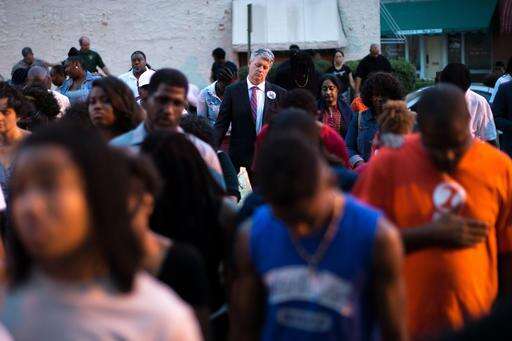
Members of the community join hands during a Black Lives Matter prayer vigil in front of the First Baptist Church, a predominantly African-American congregation, in Macon, Ga., on Monday, July 11, 2016. The pastors of both First Baptist Churches in Macon are trying to bridge the stubborn divide of race against a painful and tumultuous backdrop: the 2015 massacre at a historic black church in Charleston, South Carolina; the much-publicized deaths of blacks at the hands of law enforcement; the rise of the Black Lives Matter movement, and the sniper killing of white Dallas police officers. (AP Photo/Branden Camp)
The Associated Press
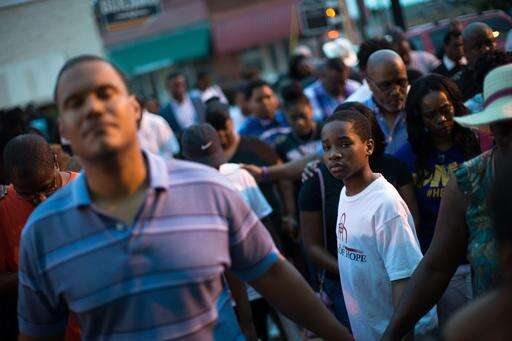
Marty Price, 11, attends a Black Lives Matter prayer vigil on the steps of the First Baptist Church, a predominantly African-American congregation, in Macon, Ga., on Monday, July 11, 2016. The pastors of both First Baptist Churches in Macon are trying to bridge the stubborn divide of race against a painful and tumultuous backdrop: the 2015 massacre at a historic black church in Charleston, South Carolina; the much-publicized deaths of blacks at the hands of law enforcement; the rise of the Black Lives Matter movement, and the sniper killing of white Dallas police officers. (AP Photo/Branden Camp)
The Associated Press
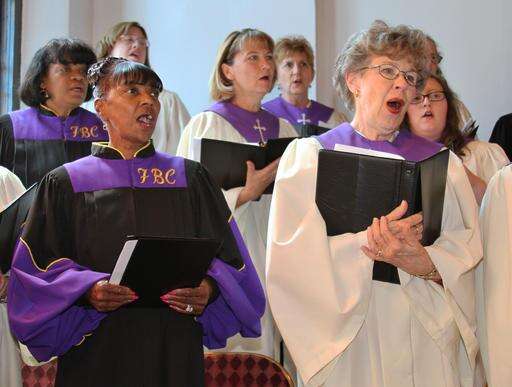
In this Sunday, May 24, 2015 photo provided by Sheryle Burger, members of Macon, Ga.'s two First Baptist Church congregations sing together in a choir during a Pentecost Sunday service held in the Rev. James Goolsby's church. There are two First Baptist Churches in Macon _ one black and one white. Two years ago, Goolsby and the Rev. Scott Dickison met to try to find a way the congregations, neighbors for so long, could become friends. They'd try to bridge the stubborn divide of race. (Sheryle Burger via AP)
The Associated Press
The Rev. James W. Goolsby, Jr., pastor of the First Baptist Church, left, and the Rev. Scott Dickison, pastor of the First Baptist Church of Christ, walk together in Macon, Ga., on Monday, July 11, 2016. In September 2016, they plan to lead joint discussions with their churches' members on racism in the history of the U.S., and also in the history of their congregations. (AP Photo/Branden Camp)
The Associated Press
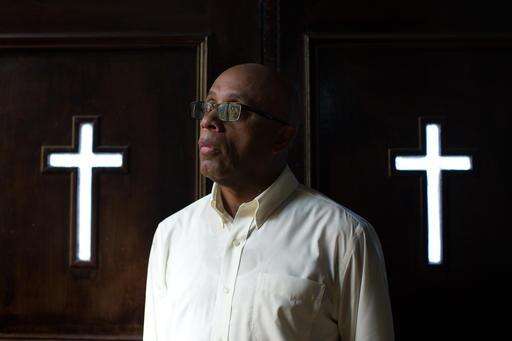
The Rev. James W. Goolsby, Jr. poses for a portrait at the First Baptist Church, a predominantly African-American congregation, in Macon, Ga., on Monday, July 11, 2016. The 59-year-old Atlanta native and graduate of Morehouse College and Mercerâs McAfee School of Theology, has been the pastor here for more than 12 years. He said he and a previous pastor at the white church tried to build ties between the congregations but the effort didnât go very far. This time is different, he said, in part because of his relationship with the new pastor, Scott Dickison. (AP Photo/Branden Camp)
The Associated Press
In this Monday, July 11, 2016 photo, the Rev. Scott Dickison poses for a portrait at the First Baptist Church of Christ, a predominantly white congregation, in Macon, Ga. The 33-year-old North Carolina native and Harvard Divinity School graduate became the pastor about four years ago. (AP Photo/Branden Camp)
The Associated Press
Parishioner Bea Warbington-Ross sings during a worship service at First Baptist Church, a predominantly African-American congregation, in Macon, Ga., on Sunday, July 10, 2016. The retired human resources specialist says, "Thereâs no reason for Sunday to be the most segregated day." (AP Photo/Branden Camp)
The Associated Press
The Rev. Scott Dickison teaches from a book of sermons by Martin Luther King Jr. during a Sunday School class at the First Baptist Church of Christ, a predominantly white congregation, in Macon, Ga., on Sunday, July 10, 2016. This class was held days after the fatal police shootings of Alton Sterling in Louisiana and Philando Castile in Minnesota, and the fatal ambush on Dallas police. "Itâs weeks like these when we need more than ever to be with Godâs people," Dickison told the roomful of congregants. (AP Photo/Branden Camp)
The Associated Press
Paul Bronson prays during a Black Lives Matter prayer vigil at First Baptist Church, a predominantly African-American congregation, in Macon, Ga., on Monday, July 11, 2016. The pastors of both First Baptist Churches in Macon are trying to bridge the stubborn divide of race against a painful and tumultuous backdrop. (AP Photo/Branden Camp)
The Associated Press
This Sunday, July 10, 2016 photo shows the exterior of the First Baptist Church of Christ, a predominantly white church, in Macon, Ga. In the early 19th century, before the Civil War, whites and blacks often worshipped together, sharing faith but not pews; blacks were restricted to galleries or the back of the sanctuary. Eventually, black populations started growing faster in many communities. Whites, made uneasy by the imbalance, responded by splitting up the congregations. This was apparently the case for First Baptist in Macon. (AP Photo/Branden Camp)
The Associated Press
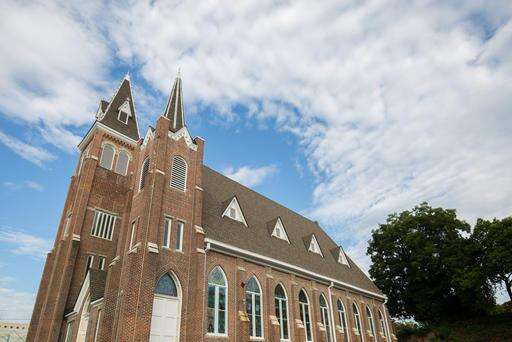
This Monday, July 11, 2016 photo shows the exterior of First Baptist Church, now a predominantly African-American congregation, in Macon, Ga. In 1845, church leaders bought this property a block away from the original building, as "a place and habitation for the religious service and moral cultivation and improvement of the colored portion" of the congregation, according to the deed. A building was quickly erected and the black church opened. (AP Photo/Branden Camp)
The Associated Press
Paul Bronson, left, joins hands with District Attorney David Cooke during a Black Lives Matter prayer vigil at First Baptist Church, with a predominantly African-American congregation, in Macon, Ga., on Monday, July 11, 2016. Pastors of both First Baptist Churches in Macon are trying to bridge the stubborn divide of race against a painful and tumultuous backdrop. (AP Photo/Branden Camp)
The Associated Press